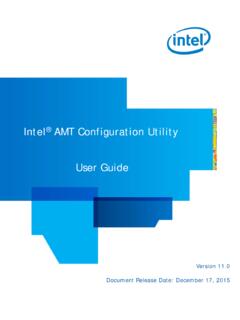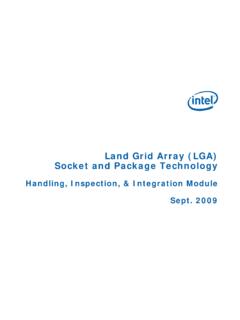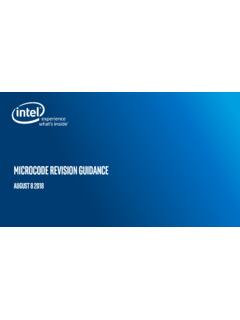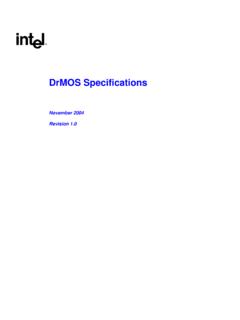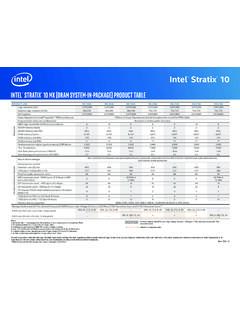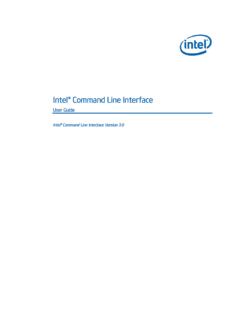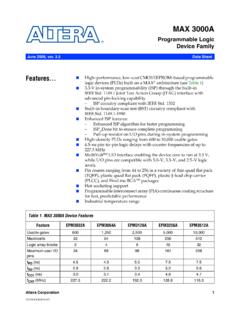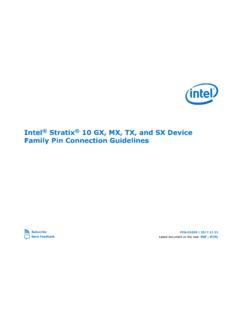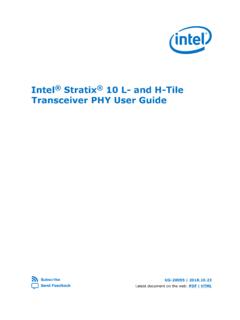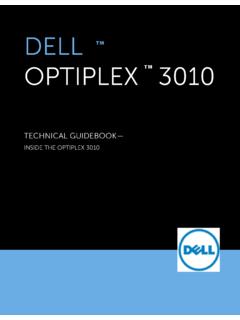Transcription of Intel® Arria® 10 Device Overview
1 Intel Arria 10 Device Overview Subscribe A10- Overview | Send Feedback Latest document on the web: PDF | HTML. Contents Contents Intel Arria 10 Device 3. Key Advantages of Intel Arria 10 4. Summary of Intel Arria 10 4. Intel Arria 10 Device Variants and Intel Arria 10 Intel Arria 10 11. Intel Arria 10 14. I/O Vertical Migration for Intel Arria 10 17. Adaptive Logic 17. Variable-Precision DSP Embedded Memory 20. Types of Embedded 21. Embedded Memory Capacity in Intel Arria 10 21. Embedded Memory Configurations for Single-port 22. Clock Networks and PLL Clock 22. Clock 22. Fractional Synthesis and I/O FPGA General Purpose 23.
2 External Memory 24. Memory Standards Supported by Intel Arria 10 24. PCIe Gen1, Gen2, and Gen3 Hard 26. Enhanced PCS Hard IP for Interlaken and 10 Gbps 26. Interlaken 26. 10 Gbps Ethernet 26. Low Power Serial Transceiver 28. PMA 29. PCS 30. SoC with Hard Processor 32. Key Advantages of 20-nm Features of the FPGA Configuration and HPS 37. Hardware and Software 37. Dynamic and Partial 37. Dynamic Partial 37. Enhanced Configuration and Configuration via 38. SEU Error Detection and 39. Power 40. Incremental 40. Document Revision History for Intel Arria 10 Device 40. Intel Arria 10 Device Overview Send Feedback 2. A10- Overview | Send Feedback Intel Arria 10 Device Overview The Intel Arria 10 Device family consists of high-performance and power-efficient 20 nm mid-range FPGAs and SoCs.
3 Intel Arria 10 Device family delivers: Higher performance than the previous generation of mid-range and high-end FPGAs. Power efficiency attained through a comprehensive set of power-saving technologies. The Intel Arria 10 devices are ideal for high performance, power-sensitive, midrange applications in diverse markets. Table 1. Sample Markets and Ideal Applications for Intel Arria 10 Devices Market Applications Wireless Channel and switch cards in remote radio heads Mobile backhaul Wireline 40G/100G muxponders and transponders 100G line cards Bridging Aggregation Broadcast Studio switches Servers and transport Videoconferencing Professional audio and video Computing and Storage Flash cache Cloud computing servers Server acceleration Medical Diagnostic scanners Diagnostic imaging Military Missile guidance and control Radar Electronic warfare Secure communications Related Information Intel Arria 10 Device Handbook.
4 Known Issues Lists the planned updates to the Intel Arria 10 Device Handbook chapters. Intel Arria 10 GX/GT Device Errata and Design Recommendations Intel Arria 10 SX Device Errata and Design Recommendations Intel Corporation. All rights reserved. Intel, the Intel logo, Altera, Arria, Cyclone, Enpirion, MAX, Nios, Quartus and Stratix words and logos are trademarks of Intel Corporation or its subsidiaries in the and/or other countries. Intel warrants performance of its FPGA and semiconductor products to current specifications in ISO. accordance with Intel's standard warranty, but reserves the right to make changes to any products and services 9001:2015.
5 At any time without notice. Intel assumes no responsibility or liability arising out of the application or use of any Registered information, product, or service described herein except as expressly agreed to in writing by Intel. Intel customers are advised to obtain the latest version of Device specifications before relying on any published information and before placing orders for products or services. *Other names and brands may be claimed as the property of others. Intel Arria 10 Device Overview A10- Overview | Key Advantages of Intel Arria 10 Devices Table 2. Key Advantages of the Intel Arria 10 Device Family Advantage Supporting Feature Enhanced core architecture Built on TSMC's 20 nm process technology 60% higher performance than the previous generation of mid-range FPGAs 15% higher performance than the fastest previous-generation FPGA.
6 High-bandwidth integrated Short-reach rates up to Gigabits per second (Gbps). transceivers Backplane capability up to Gbps Integrated 10 GBASE-KR and 40 GBASE-KR4 Forward Error Correction (FEC). Improved logic integration and 8-input adaptive logic module (ALM). hard IP blocks Up to megabits (Mb) of embedded memory Variable-precision digital signal processing (DSP) blocks Fractional synthesis phase-locked loops (PLLs). Hard PCI Express Gen3 IP blocks Hard memory controllers and PHY up to 2,400 Megabits per second (Mbps). Second generation hard Tight integration of a dual-core ARM Cortex-A9 MPCore processor, hard IP, and an processor system (HPS) with FPGA in a single Intel Arria 10 system-on-a-chip (SoC).
7 Integrated ARM* Cortex*-A9* Supports over 128 Gbps peak bandwidth with integrated data coherency between MPCore* processor the processor and the FPGA fabric Advanced power savings Comprehensive set of advanced power saving features Power-optimized MultiTrack routing and core architecture Up to 40% lower power compared to previous generation of mid-range FPGAs Up to 60% lower power compared to previous generation of high-end FPGAs Summary of Intel Arria 10 Features Table 3. Summary of Features for Intel Arria 10 Devices Feature Description Technology TSMC's 20-nm SoC process technology Allows operation at a lower VCC level of V instead of the V standard VCC core voltage Packaging mm ball-pitch Fineline BGA packaging mm ball-pitch Ultra Fineline BGA packaging Multiple devices with identical package footprints for seamless migration between different FPGA densities Devices with compatible package footprints allow migration to next generation high-end Stratix 10 devices RoHS, leaded(1), and lead-free (Pb-free)
8 Options High-performance Enhanced 8-input ALM with four registers FPGA fabric Improved multi-track routing architecture to reduce congestion and improve compilation time Hierarchical core clocking architecture Fine-grained partial reconfiguration Internal memory M20K 20-Kb memory blocks with hard error correction code (ECC). blocks Memory logic array block (MLAB) 640-bit memory (1) Contact Intel for availability. Intel Arria 10 Device Overview Send Feedback 4. Intel Arria 10 Device Overview A10- Overview | Feature Description Embedded Hard IP Variable-precision DSP Native support for signal processing precision levels from 18 x 19 to blocks 54 x 54.
9 Native support for 27 x 27 multiplier mode 64-bit accumulator and cascade for systolic finite impulse responses (FIRs). Internal coefficient memory banks Preadder/subtractor for improved efficiency Additional pipeline register to increase performance and reduce power Supports floating point arithmetic: Perform multiplication, addition, subtraction, multiply-add, multiply-subtract, and complex multiplication. Supports multiplication with accumulation capability, cascade summation, and cascade subtraction capability. Dynamic accumulator reset control. Support direct vector dot and complex multiplication chaining multiply floating point DSP blocks.
10 Memory controller DDR4, DDR3, and DDR3L. PCI Express* PCI Express (PCIe*) Gen3 (x1, x2, x4, or x8), Gen2 (x1, x2, x4, or x8). and Gen1 (x1, x2, x4, or x8) hard IP with complete protocol stack, endpoint, and root port Transceiver I/O 10 GBASE-KR/40 GBASE-KR4 Forward Error Correction (FEC). PCS hard IPs that support: 10-Gbps Ethernet (10 GbE). PCIe PIPE interface Interlaken Gbps Ethernet (GbE). Common Public Radio Interface (CPRI) with deterministic latency support Gigabit-capable passive optical network (GPON) with fast lock- time support JESD204b 8B/10B, 64B/66B, 64B/67B encoders and decoders Custom mode support for proprietary protocols Core clock networks Up to 800 MHz fabric clocking, depending on the application.
